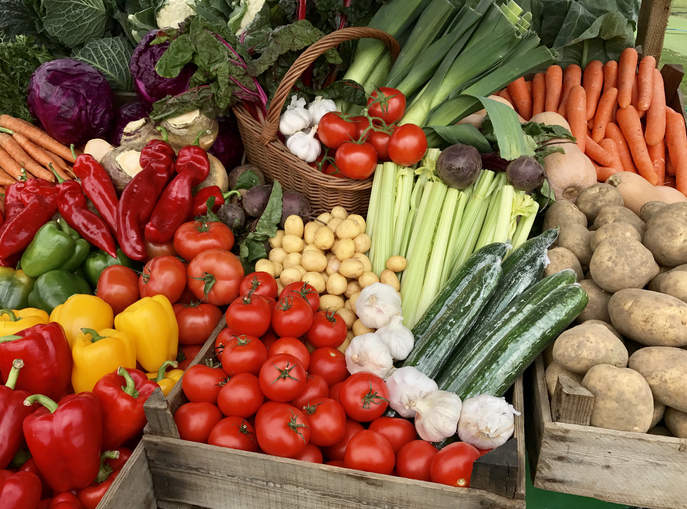
Recently I’ve become known to my clients as the “Vegetable Pitchman Dietitian.” I’ve gotten this name because I advise them to fill half their plates at lunch and supper with non-starchy vegetables. Unfortunately this advice is not often popular with my clients. We’re still in search of a magic health bullet that can easily be purchased without a big price tag, and promoted on social media as “the cure for everything.”
I know my advice requires a bit of a lifestyle adjustment, but it’s a very do-able adjustment for almost everyone if we’re committed, and if we also have a few simple meal planning tips in our arsenal.
Starchy vs. Non-Starchy Vegetables
Let me first explain the difference between starchy and non-starchy vegetables. Starchy veggies have more carbohydrates and can increase blood sugar at a faster rate. Examples of starchy vegetables include: potatoes, corn, parsnips, peas, pumpkin, acorn squash, butternut squash and plantains.
Non-starchy veggies have lower amounts of carbs and calories compared to their starchier counterparts. A few examples are: asparagus, salad greens, yellow squash, tomatoes, eggplants, zucchini, turnips, turnip/collard/kale/mustard greens, cucumbers, onions and green onions, cauliflower, broccoli, Brussel sprouts, green beans, peppers (all types), celery, radishes, spinach, okra, and mushrooms.
The Veggie Pitch
The benefits of adding more vegetables to our diets are tremendous for good health, good glycemic control, and weight management. Non-starchy vegetables in particular provide fiber, a small amount of protein, vitamins and minerals, and plenty of cancer-fighting antioxidants.
Additionally, they:
- Stabilize our glucose (along with protein and fiber)
- Provide volume to our meals
- Improve digestion
- Offer a ton of variety and opportunity for new recipes
Our bodies are designed to consume non-starchy vegetables regularly. They aid digestion and bowel movement regularity (just be sure to drink your water to help the digestive process). I consider non-starchy vegetables a “non-negotiable” in our daily eating plan….they just have to be there!
With a few more vegetables on our plate, we can eat more food with less carbs and calories. I find this helps us better control our portions of carbohydrate foods, particularly starch. This is a big deal!
Tip #1
Let’s say we’re having pizza tonight. If we fill half our plate with salad we’ll have less room for the pizza and we should be better able to resist second helpings.
Or, what if we’re having a burger? I recommend also ordering a non-starchy vegetable and a side salad. If we have all (or even some!) of the salad and side veggie, we may only eat half of the burger and fries. Most of us would agree that without the vegetables, it would be hard to stop at just half the burger. This makes having a burger a reasonable choice on occasion.
Tip # 2
Another trick to boosting our veggie intake is to make them really easily accessible. A great way to do that is to follow a three step process for grocery shopping:
- Plan
- Shop
- Prep
Before you head to the store, plan out at least a few basic, easily prepared meals and snacks for the week. While you’re shopping, load up on a variety of vegetables (both fresh and frozen) and shop the perimeter of the store to include whole foods instead of the more processed varieties.
After you get home, prep your veggies for the week. Wash, chop and store them in containers with pre-portioned sizes so they’re easier to grab on the go. Cherry tomatoes, carrots, sliced cucumbers, sliced peppers, green beans, celery, broccoli and cauliflower florets all make great options for quick snacks or sides.
Tip # 3
Finally, when cooking vegetables, make enough for a couple of meals. Keep it interesting by preparing them in different ways to add more variety. You can sauté, roast, boil, blanch, grill, steam, stir fry, and of course keep them raw. Enjoying a cup of raw vegetables with a tablespoon of ranch dip is a great way to add a little extra flavor without a lot of extra calories.
It’s important to note there are times that this intake of non-starchy vegetables would not be recommended, for instance a person living with chronic kidney disease may need to monitor their high potassium intake and would need to work with a registered dietitian for meal planning recommendations.
I hope you’re sold on my advice to have half of your plate at lunch and supper consist of non-starchy vegetables, and be consistent with this each day. If half a plate seems too overwhelming at first, even adding a little more than usual and working your way up to half a plate is a manageable adjustment, and a change that is worth buying into for your health.


This is an excellent article with practical advice that most people can apply to their meal plans. Great suggestions for patients.
Thank you, Susan!
Thanks for your comment, Jeri!
You know, I was diagnosed diabetic almost 6 years ago now. No one, no doctor, no dietitian, not even the pamphlets they gave me every said “Eat your non starchy vegetables”.
I was told meat was evil, I was told fat was evil. I was told to make sure I get my minimum of whole grains (like you will honestly find that in most grocery stores) and fruits. No one ever said, eat your broccoli, or spinach, asparagus, or similar.
Thank you for saying it. More need to do so.
Thank you for the very life changing tips! I am in my late 40’s, wt 135, 5.5 and I’m really feeling the weight; figuratively speaking lol. With the tips you shared I will be able to make myself a weekly meal plan. Thank you. Thank you. And Happy Holidays to you and your family.
You’re so welcome, and Happy Holidays to you too!
I’m looking for a good low potassium diet due to my potassium testing high (5.7) even though my A1c is 5.6 and fasting glucose is now 98. Perplexed. Any suggestions.
The National Kidney Foundation has a great resource here:
https://www.kidney.org/sites/default/files/NKF_Guide_to_Low_Potassium_Diet_Final_0.pdf